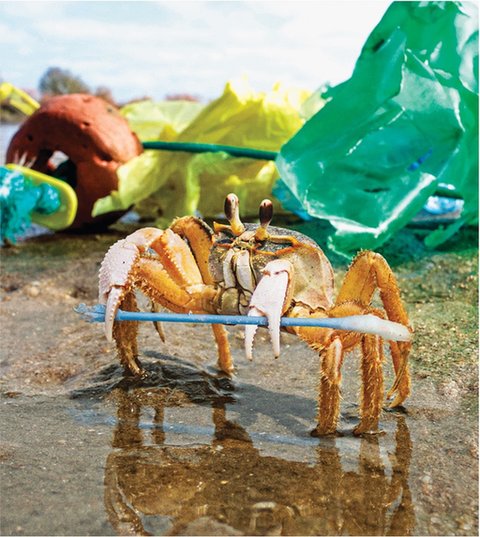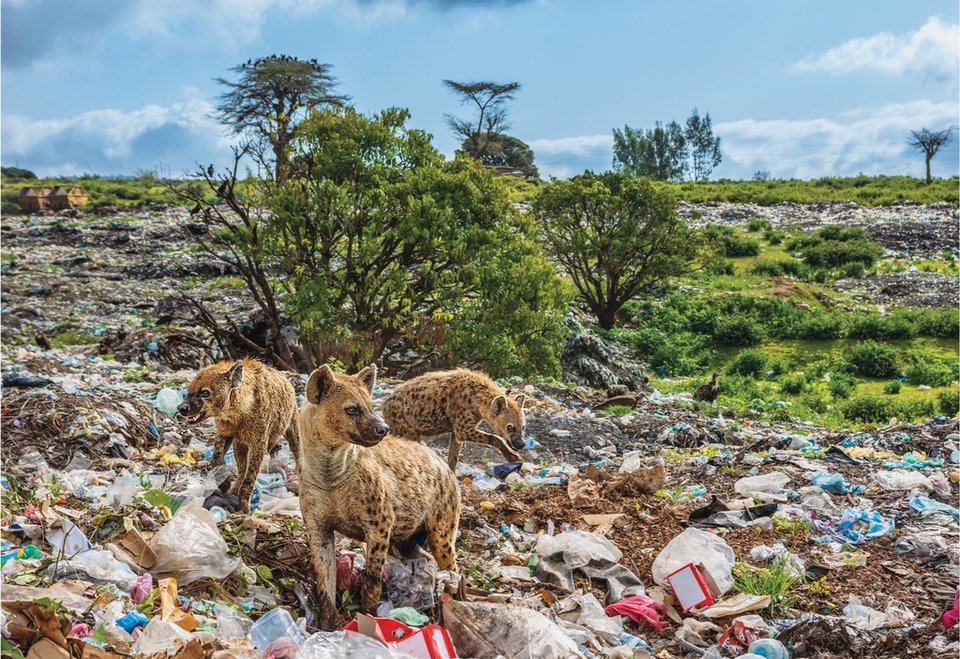
Acrabclutchesacottonswabitfoundona beach.
DangertoAnimals
Oceanplastickillsmillionsofmarineanimalseachyear.Nearly700specieshavebeenaffectedbyit.Thisincludesendangered species.
Somearestrangledbyabandonedfishingnetsordiscardedsix‑packrings.Seaturtlesandtoothedwhalesgulpdownplasticbags.Theythinktheplasticisajellyfish.Birdslikealbatrosshavebeenfounddeadwithstomachsfullofplastic garbage.
Microplastics areadanger,too.Theyaresmallplasticpieceslessthanfivemillimeters(one‑fifthofaninch)long.Animalseatthemwithoutknowing it.

Aseaturtlesetsitssightsonaplastic cup.
Seabirdsscoopupfloatingplasticpellets.Thesecanresemblefisheggs.Parentbirdsthenspituptheplastictofeedtheiryoung.Butplasticdoesn’tprovidenutrients.Itkillsthe animals.
Incrabs,microplasticsremaininthegutsixtimeslongerthanfooddoes.Whenapredatorlikeabirdeatsamarineworm,thebirdgetsalessnutritiousmeal.Italsogetstheplasticthatwormhaseaten.That’showplasticpassesupthefood chain.

EvenhyenasencounterplasticastheyscavengealandfillinEthiopia,acountryin Africa.
LookingfortheSource
Tokeepplasticoutofouroceans,weneedtoknowhowit’sgettingthere.Today,weproducemoreplasticthanwecandisposeof.“Thisisn’taproblemwherewedon’tknowwhatthesolutionis”, saysTedSiegler,aresourceeconomist.Heshouldknow.He’sspentthelast25yearsstudying garbage.
“Therealityis,wejustneedtocollectthetrash.MostcountriesthatIworkin,youcan’tevengetitoffthestreet.”Moregarbagetrucksandabettersystemwould help.
Sieglersuggeststwootherwaystotackletheproblem.First,designnewplasticsandnewplasticproducts.They mustbebiodegradableormorerecyclable, however.
Second,helpcountriesthatneedbetter wasteremovalsystems.Sieglersuggestsatax.Companieswouldpayapennyoneverypoundofplastictheymanufactured.Thetaxwouldraiseroughlysixbilliondollarsayear.Thatmoneycouldbeusedtomanagegarbagecollectionindeveloping nations.
